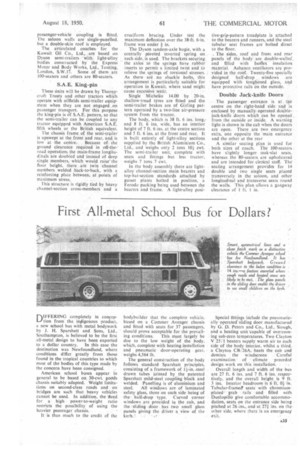First All-metal School Bus for Dollars?
Page 45

If you've noticed an error in this article please click here to report it so we can fix it.
DIFFERING completely in conceptiontion from the indigenous product, a new school bus with metal bodywork by I. H. Sparshatt and Sons, Ltd., Southampton, is believed to be the first all-metal design to have been exported
to a dollar country. In this case the destination was Newfoundland, where conditions differ greatly from those found in the tropical countries to which most of the bodies of this type made by the concern have been consigned. •
American school buses appear in general to be based on 30-cwt. goods chassis suitably adapted. Weight limitations on second-class roads and on bridges are such that heavy vehicles cannot be used. In addition, the deed for a high power-to-weight ratio restricts the possibility of using the
heavier passenger chassis. • It is thus much to the credit of the bodybuilder that the complete vehicle, based on a Commer Avenger chassis and fitted with seats for 37 passengers, should prove acceptable for the prevail ing conditions. This must largely be due to the low weight of the body. which, complete with heating installation and pneumatic door-operating gear, weighs 4,564 lb.
The general construction of the body follows standard Sparshatt principles, consisting of a framework of 14-in.-steel drawn tubes jointed by the patented Sparshatt mild-steel coupling block and welded. Panelling is of aluminium and steel. All windows are of laminated safety glass, three on each side being of the half-drop type. Curved corner windows are provided in the cab, and the sliding .door has two small glass panels giving the driver a view of the kerb.' -t Special fittings include the pneumatically operatedsliding door manufactured by G. D. Peters and Co., Ltd., Slough. and a heating unit capable of overcoming sub-zero temperatures. Two Clayton V 25/1 heaters supply warm air to each side of the body interior, whilst a third. a Clayton CB/26A, -heats the cab and demists the windscreen 'Careful examination of • climate preceded design work on this installation.
Overall length and width of the bus are 27 ft. 6 ins. and 7 ft. 6 ins, respectively, and the overall height is 9 ft. 3 ins. Interior headroom is 6 ft. 04•1n. Tubular-framed' seats with chromiumplatedgrab rails and filled with Dunio-pille give comfortable accommodation, seats on the entrance side being pitched at 26 ins., and at 274 ins, on the other side, where there is an emergency exit.












































































